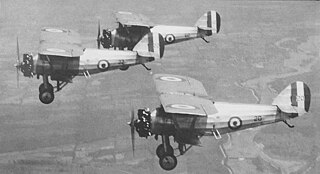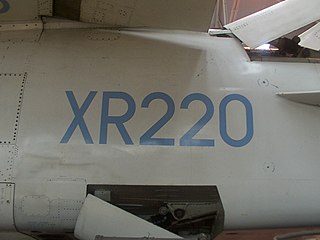1940s

The presentation was changed to look like a military serial for security reasons during the Second World War. [1] For example, the prototype de Havilland Mosquito was allocated test markings E-0234.
United Kingdom aircraft test serials are used to externally identify aircraft flown within the United Kingdom without a full Certificate of Airworthiness. [1] They can be used for testing experimental and prototype aircraft or modifications, pre-delivery flights for foreign customers and are sometimes referred to as "B" class markings. [1]
An initial set of markings was introduced in 1929, each company was allocated a letter to which would follow a number, sometimes with a hyphen or a gap between. [1] For example, A was allocated to the Armstrong Whitworth Aircraft and A 1 was used in March 1930 on an Armstrong Whitworth Starling. [1] Sometimes Hawker and Vickers would also add the letters PV to the markings to indicate a private venture (that is a type in development not paid for by the Air Ministry). [1]

The presentation was changed to look like a military serial for security reasons during the Second World War. [1] For example, the prototype de Havilland Mosquito was allocated test markings E-0234.
Following a change back to the original system in 1946 a new system was introduced on 1 January 1948. [1] Each company was allocated a number which followed the British nationality marking G and then followed by an individual identity number. [1] For example, Blackburn Aeroplane & Motor Company were allocated G-2 and the first allocation G-2-1 was used on a Miles Messenger used as an engine testbed for the Cirrus Bombardier. [1] Companies could allocate and re-use the identities as they liked, some ran in sequence from 1 and others used the aircraft manufacturers serial number as part of the marking, for example G-51-200 was a Britten Norman Islander with a manufacturers serial number of 200. [1] Allocations of codes from defunct companies have been reallocated.

| Allocation | Company | Notes |
|---|---|---|
| A | Armstrong Whitworth Aircraft | Replaced by G-1 in 1948 |
| B | Blackburn Aeroplane & Motor Company | Replaced by G-2 in 1948 |
| C | Boulton Paul | Replaced by G-3 in 1948 |
| D | Portsmouth Aviation | Replaced by G-4 in 1948 |
| E | de Havilland | Replaced by G-5 in 1948 |
| F | Fairey Aviation | Replaced by G-6 in 1948 |
| G | Gloster Aircraft | Replaced by G-7 in 1948 |
| H | Handley Page | Replaced by G-8 in 1948 |
| I | Hawker Aircraft | Replaced by G-9 in 1948 |
| J | Parnall Aircraft | Out of use by 1946 |
| J | Reid & Sigrist | From 1947, replaced by G-10 in 1948 |
| K | Avro | Replaced by G-11 in 1948 |
| L | Saunders-Roe | Replaced by G-12 in 1948 |
| M | Short Brothers | Replaced by G-14 in 1948 |
| N | Supermarine | Replaced by G-15 in 1948 |
| O | Vickers Armstrongs | Replaced by G-16 in 1948 |
| P | Westland Aircraft | Replaced by G-17 in 1948 |
| R | Bristol Aeroplane | Replaced by G-18 in 1948 |
| S | Spartan Aircraft | Out of use by 1936 |
| S | Heston Aircraft | Replaced by G-19 in 1948 |
| T | General Aircraft | Replaced by G-20 in 1948 |
| U | Phillips & Powis later Miles Aircraft | Replaced by G-21 in 1948 |
| V | Airspeed | Replaced by G-22 in 1948 |
| W | G & J Weir | 1933–1946 |
| X | Percival Aircraft | Replaced by G-23 in 1948 |
| Y | British Aircraft Manufacturing | Out of use by 1938 |
| Y | Cunliffe-Owen | 1940–1947, replaced by G-24 in 1948 |
| Z | Auster Aircraft | Replaced by G-25 in 1948 |
| AB | Slingsby Sailplanes | Replaced by G-26 in 1948 |
A serial number is a unique identifier assigned incrementally or sequentially to an item, to uniquely identify it.
British military aircraft designations are used to refer to aircraft types and variants operated by the armed forces of the United Kingdom.
Vickers-Armstrongs Limited was a British engineering conglomerate formed by the merger of the assets of Vickers Limited and Sir W G Armstrong Whitworth & Company in 1927. The majority of the company was nationalised in the 1960s and 1970s, with the remainder being divested as Vickers plc in 1977.

The Armstrong Whitworth Siskin was a sesquiplane single-seat fighter aircraft developed and produced by the British aircraft manufacturer Armstrong Whitworth Aircraft. It was also the first all-metal fighter to be operated by the Royal Air Force (RAF), as well as being one of the first new fighters to enter service following the end of the First World War.

The Fairey Gannet is a carrier-borne aircraft that was designed and produced by the British aircraft manufacturer the Fairey Aviation Company. It was developed for the Royal Navy, being the first fixed-wing aircraft to combine both the search and strike portions of anti-submarine warfare (ASW) operations to be operated by the Fleet Air Arm (FAA).

The Armstrong Whitworth Argosy was a British post-war transport/cargo aircraft; it was the final aircraft to be designed and produced by aviation company Armstrong Whitworth Aircraft. Although given different internal design numbers, the AW.650 civil and AW.660 military models were, for most practical purposes, the same design, while both models also shared the "Argosy" name.

The Gloster Aircraft Company was a British aircraft manufacturer from 1917 to 1963.
Sir W. G. Armstrong Whitworth Aircraft Company, or Armstrong Whitworth Aircraft, was a British aircraft manufacturer.

An aircraft registration is a code unique to a single aircraft, required by international convention to be marked on the exterior of every civil aircraft. The registration indicates the aircraft's country of registration, and functions much like an automobile license plate or a ship registration. This code must also appear in its Certificate of Registration, issued by the relevant civil aviation authority (CAA). An aircraft can only have one registration, in one jurisdiction, though it is changeable over the life of the aircraft.

The Armstrong Whitworth A.W.27 Ensign was a British four-engine monoplane airliner and the largest airliner built in Britain during the Interwar period.

The Armstrong Whitworth A.W.52 was an early flying wing aircraft designed and produced by British aircraft manufacturer Armstrong Whitworth Aircraft.

The Armstrong Whitworth AW.15 Atalanta was a four-engine airliner designed and produced by the British aircraft manufacturer Sir W.G. Armstrong Whitworth Aircraft Limited at Coventry.

United Kingdom military aircraft serial numbers are aircraft registration numbers used to identify individual military aircraft in the United Kingdom (UK). All UK military aircraft are allocated and display a unique registration number. A unified registration number system, maintained initially by the Air Ministry (AM), and its successor the Ministry of Defence (MoD), is used for aircraft operated by the Royal Air Force (RAF), Fleet Air Arm (FAA), and Army Air Corps (AAC). Military aircraft operated by government agencies and civilian contractors are also assigned registration numbers from this system.

The Armstrong Whitworth AW.55 Apollo was a 1940s British four-engine turboprop airliner built by Armstrong Whitworth at Baginton. The aircraft was in competition with the Vickers Viscount but was beset with engine problems and only two were built.

In the United States, all military aircraft display a serial number to identify individual aircraft. These numbers are located on the aircraft tail, so they are sometimes referred to unofficially as "tail numbers". On the Northrop Grumman B-2 Spirit bomber, lacking a tail, the number appears on the nose gear door. Individual agencies have each evolved their own system of serial number identification. Aircraft serials are part of the Aircraft Visual Identification System, which also includes the aircraft's tail code and Modex.

The Armstrong Whitworth A.W.19 was a two/three-seat single-engine biplane, built as a general-purpose military aircraft in the mid-1930s. A newer, monoplane aircraft was preferred and only one A.W.19 was built.
Heston Aircraft Company was a British aircraft manufacturer based at Heston Aerodrome, Middlesex, England.

Belgian owned and operated aircraft are identified by either registration letters or serial numbers for military aircraft.

United Kingdom aircraft registration is a register and means of identification for British owned and operated commercial and private aircraft, they are identified by registration letters starting with the prefix G-.

Aviation call signs are communication call signs assigned as unique identifiers to aircraft.